Homebush, New South Wales
| Homebush Sydney, New South Wales | |||||||||||||
|---|---|---|---|---|---|---|---|---|---|---|---|---|---|
|
Library, Rochester Street | |||||||||||||
| Coordinates | 33°51′51″S 151°04′56″E / 33.86406°S 151.08234°ECoordinates: 33°51′51″S 151°04′56″E / 33.86406°S 151.08234°E | ||||||||||||
| Population | 6,195 (2011 census)[1] | ||||||||||||
| Postcode(s) | 2140 | ||||||||||||
| Location | 15 km (9 mi) west of Sydney CBD | ||||||||||||
| LGA(s) | Municipality of Strathfield | ||||||||||||
| State electorate(s) | Strathfield | ||||||||||||
| Federal Division(s) | Reid | ||||||||||||
| |||||||||||||
Homebush is a suburb in the Inner West[2] of Sydney, in the state of New South Wales, Australia. It is located 15 kilometres west of the Sydney central business district, in the local government area of the Municipality of Strathfield. Homebush is located south of Homebush Bay, an inlet of the Parramatta River. and north Homebush West.
History
The first name of settlement at what is today called Homebush was "Liberty Plains". This was a group of grants given to the Colony's first free settlers, who came on the ship "Bellona", in 1793. Most of the original settlers soon departed for agriculturally more attractive places, like the Hawkesbury. One of them, Edward Powell, later returned and established there the Half Way House Inn, on Parramatta Road just west of the creek that now bears his name. Later, when the Great Western Railway line came through there, with a station just behind Powell's inn, the name Homebush was borrowed from the nearest large estate, that of D'Arcy Wentworth. A shopping centre by the name of Homebush has since grown around the railway station of that name. There also used to be a Ford factory in Homebush, which manurfactured the Telstar and the Laser. But the factory closed in 1994.
It is commonly thought that the property and house with the name of Homebush was established and named by the Colony's then assistant surgeon D'Arcy Wentworth. Historian Michael Jones who had been commissioned by Stathfield Council to write the history of that Municipality wrote: "Wentworth is popularly credited with having called the area after his 'home in the bush', although Homebush is also a place in Kent".[3] It is considered unlikely that it was named after the village in Kent as D'Arcy Wentworth was Irish and had no links to the English county.[4] According to local historian David Patrick [5] it wasn’t D'Arcy Wentworth who named Homebush but an earlier grantee on the land – that being the military figure Thomas Laycock. It would appear that after Laycock became mentally ill, following his direct involvement in suppressing the Castle Hill convict rebellion D'Arcy Wentworth became his doctor. It has been reputed that D'Arcy Wentworth either bought the Laycock Homebush Farm from Laycock or, more fancifully, won the property in an unfair game of cards from the ailing Laycock. Wentworth retained Thomas Laycock's name of the property and added to its extent. Laycock had been granted 40 hectares in 1794 and increased this to 318 hectares by 1803 and named it "Home Bush". A notice that Laycock placed in the newspapers about his property "Home Bush" is from before when Wentworth acquired the land from him. Later on, Wentworth acquired more land there himself and the estate had grown to 990 acres by 1811. Homebush once had a very famous racecourse, established by Wentworth.
Village of Homebush
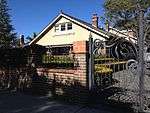
Burlington Road
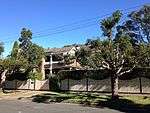
Meredith Street

Abbotsford Road
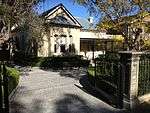
Abbotsford Road
The Village of Homebush estate was a section of the Underwood Estate located to the south of the railway. The land had boundaries of The Crescent, Homebush, Beresford, Coventry and Bridge Roads, was subdivided in 1878. Within the estate, Broughton, Abbotsford and Burlington Roads and Rochester and Meredith Streets were also gazetted. In the December of that year, 381 house blocks were auctioned. By the end of the century many large houses and substantial villas had been built. In the 20th century house construction continued and most blocks had been built on by the end of the 1920s.[6]
Houses
- Billesdon, 104 Burlington Road, was built in 1915 for Stephen Rabone to a design by Rupert Minnett.[7]
- Broughlea, 82 Abbotsford Road, was built c. 1881 for Horatio Aylward, a solicitor in the firm of Aylward and Wild.[8]
- Camden Lodge, 102 Burlington Road, was built c. 1917 for Robert Trevethan.[9]
- Dunkeld (now Edensor), 19–21 Meredith Street, was built c. 1903 for James Pearce (1857–1916), who was the proprietor of the Strathfield Flour Mills.[10]
- Florenceville, 44 Abbotsford Road, was built in the early 1880s by John Shiply.
- Hawthorn, 78–80 Abbotsford Road, was built c. 1886 for Frederick William Binney to a design by Cyril and Arthur Blacket. Binney was Secretary of the Newcastle-Wallsend Coal Company and the Northern Collieries Association.[11]
- Ingera (now Inglemere and trading as Darcy's Hotel), 2 Abbotsford Road, was built c. 1894 for William Norton.[12]
- Rothsay, 72–76 Abbotsford, was built c. 1884 for Samuel Thompson (1821–1910), who was a stockbroker.
- Warwick, 96 Abbotsford Road, was built in the early 1890s in the late Victorian style. It became known as Warwick in 1902 when it was bought by public subscription for Emily Forrester (1842–1917), widow of William Forrester (1842–1901) who had owned Warwick Farm as a private racecourse before he died owning nothing. The Forrester Fund raised £1387 and its committee paid £800 for the Homebush house.[13] Emily Forrester died at Warwick, Homebush, in 1917.[14]
Transport
Homebush railway station is the terminus of all stations services on the Airport, Inner West & South Line of the Sydney Trains network. Parramatta Road and the M4 Western Motorway are the main arterial roads passing through the suburb.
Commercial area
Homebush has a small row of shops along Rochester Street, opposite Homebush Public School. These shops extend to The Crescent, oppositeHomebush railway station. Many more shops sprang up along Parramatta Road in the past. However these are mostly now shut or abandoned-looking in common with other parts of Parramatta Road, a condition attributed to increased congestion and lack of parking. At least for the time being car sales yards continue to flourish along Parramatta Road but this main artery through Homebush has now been re-zoned high density by Strathfield Council, such that highrise can be expected to appear all along it in future.
Schools
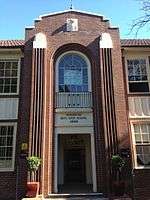
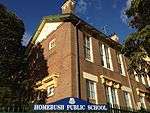
- Homebush Public School, a government primary school, was established in 1885 on its present site between The Crescent, Rochester Street and Burlington Road. Brick buildings were originally built facing The Crescent in 1897 and Burlington Road in 1916.
- Homebush Boys High School was founded in 1936 and is a comprehensive public high school for boys. Formerly a selective high school until the 1970s, Homebush Boys was regarded as one of the academically best-performing comprehensive schools, and has, in the past, been ranked above selective schools on the Higher School Certificate results.[15] The school has an enrolment of approximately 1200 students and the students and staff are from diverse backgrounds and many of them live outside the area.
Population
At the 2011 census, there were 6,195 residents in Homebush. The majority of people are immigrants, with the largest foreign countries of birth being India 11.8%, China 9.4%, Korea, Republic of (South) 8.1%, Sri Lanka 7.0% and Nepal 2.0%. Most people spoke a language other than English at home. Languages spoken at home included Korean 9.8%, Tamil 9.5%, Mandarin 8.4%, Cantonese 5.7% and Hindi 3.1%. The top religious affiliations were Catholic 21.9%, Hinduism 20.5% and No Religion 15.2%.[1]
Residents
The following were either born or have lived at some time in the suburb of Homebush:
- Thomas Keneally, author of Homebush Boy: A Memoir (1995)
- Fenella Kernebone, arts presenter
- Rosa Angela Kirkcaldie, hospital matron and army nurse [16]
- James Lang, politician
- Evan Mander-Jones, director of education [17]
- Phyllis Mander-Jones, librarian
- Warren Rodwell, former soldier, university teacher, hostage survivor [18] & songwriter [19]
- D'Arcy Wentworth, surgeon
Gallery
- Davey Square memorial
 Homebush Public School
Homebush Public School- Shops, The Crescent
- Former Homebush Post Office, The Crescent
- Horse and Jockey Hotel, Parramatta Road
- Former cinema, Parramatta Road
References
- 1 2 Australian Bureau of Statistics (31 October 2012). "Homebush (State Suburb)". 2011 Census QuickStats. Retrieved 10 May 2013.
- ↑ [Homebush West named as the inner west's most affordable suburb Homebush West named as the inner west's most affordable suburb] Retrieved 6 August 2014.
- ↑ Jones, Michael (1985). Oasis in the West: Strathfield's first hundred years. North Sydney: Allen & Unwin Australia. ISBN 0-86861-407-6 (page 15)
- ↑ Jones, Michael (1985). Oasis in the West: Strathfield's first hundred years. North Sydney: Allen & Unwin Australia. ISBN 0-86861-407-6, page 15
- ↑ pers. comm. 2014 to John Byrnes, for the "Homebush Project"
- ↑ Village of Homebush Walking Tour Retrieved 7 August 2013.
- ↑ Strathfield History Images Retrieved 7 August 2013.
- ↑ Broughlea Retrieved 7 August 2013.
- ↑ Jones, Cathy. "Camden Lodge". Strathfield Heritage Website. Retrieved 13 May 2014.
- ↑ "Family Notices.". The Leader. Orange, NSW: National Library of Australia. 7 June 1916. p. 5. Retrieved 7 August 2013.
- ↑ Hawthorne Retrieved 7 August 2013.
- ↑ Inglemere Retrieved 7 August 2013.
- ↑ "SPORTING.". The Evening News. Sydney: National Library of Australia. 16 May 1902. p. 2. Retrieved 7 August 2013.
- ↑ "Family Notices.". The Sydney Morning Herald. National Library of Australia. 2 July 1917. p. 6. Retrieved 7 August 2013.
- ↑ Board of Studies 2006 ‘HSC Report – Top schools in each region’, The Board of Studies, 23 December 2006.
- ↑ "Australian Dictionary of Biography".
- ↑ "Australian Dictionary of Biography".
- ↑ http://www.cambridgescholars.com/472-days-captive-of-the-abu-sayyaf
- ↑ http://mintmagazine.com.au/news/abducted-by-not-by-mad-cowboy-disease/
External links
| Wikimedia Commons has media related to Homebush, New South Wales. |